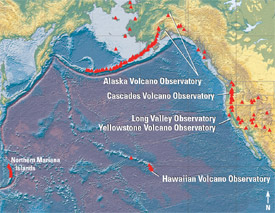Natural Hazards
Back to Natural Hazards Gateway Home
 The U.S. Geological Survey (USGS) is responsible for monitoring our Nation's 170 active volcanoes (red triangles) for signs of unrest and for issuing timely warnings of hazardous activity to government officials and the public. This responsibility is carried out by scientists at the five volcano observatories operated by the USGS Volcano Hazards Program and also by State and university cooperators. (Low-res) Natural Hazards - VolcanoesWhen the violent energy of a volcano is unleashed, the results can be catastrophic. The risks to life, property, and infrastructure are escalating as more and more people live, work, play, and travel in volcanic regions. To help keep communities safe, it is essential to monitor hazardous volcanoes so that the public knows when unrest begins and what hazards can be expected. The USGS has greatly advanced its ability to evaluate volcanic risks and hazards through research and monitoring programs. USGS realtime volcano-monitoring tools collect and transfer large amounts of data from remote volcanoes for analysis and interpretation. USGS's analyses and interpretations help the public, policymakers, and emergency managers make informed decisions on how to prepare for and react to volcano hazards and reduce losses from future volcanic eruptions and debris flows.
|